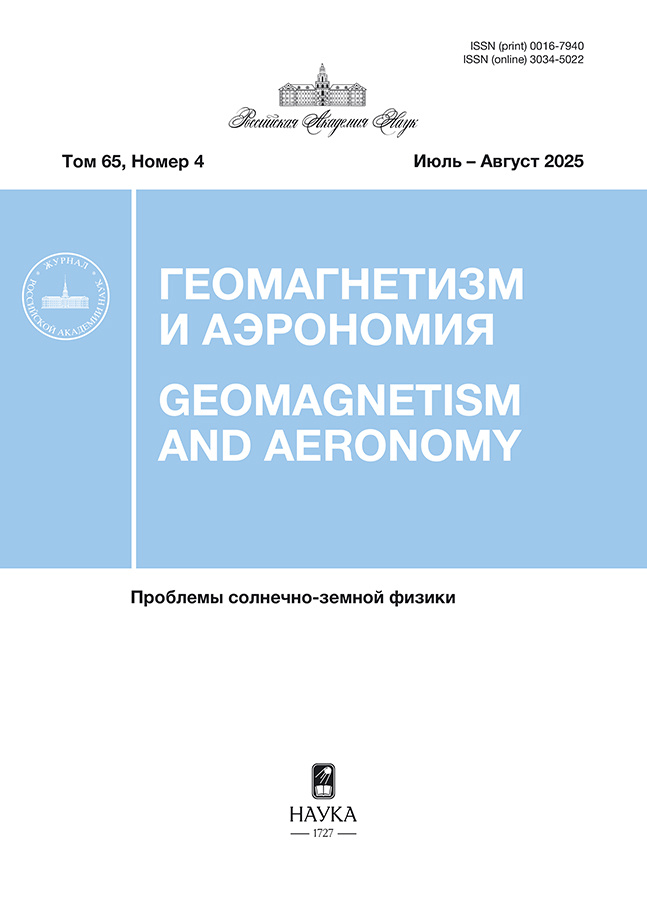Расчет жесткости геомагнитного обрезания с помощью трейсинга на основе метода Бунемана−Бориса
- Авторы: Кручинин П.А.1, Малахов В.В.1, Голубков В.С.1, Майоров А.Г.1
-
Учреждения:
- Московский инженерно-физический институт
- Выпуск: Том 64, № 6 (2024)
- Страницы: 750-759
- Раздел: Статьи
- URL: https://gynecology.orscience.ru/0016-7940/article/view/681547
- DOI: https://doi.org/10.31857/S0016794024060032
- EDN: https://elibrary.ru/QOQMPN
- ID: 681547
Цитировать
Полный текст
Аннотация
Работа включает в себя разработку метода определения жесткости геомагнитного обрезания, основанного на трассировке заряженных частиц в магнитном поле Земли по методу частица-в-ячейке, реализованного в схеме Бунемана–Бориса. Для тестирования метода были проведены расчеты жесткости геомагнитного обрезания в поле идеального диполя и в поле, заданном моделью IGRF. В первом случае полученные данные сопоставлялись с аналитическими значениями. Точность расчета в этом случае составила 3 МВ. Во втором случае была воспроизведена картина полутени в различных географических точках, за различные периоды, а также исследована устойчивость метода к малым возмущениям начальных параметров. В качестве основных результатов в работе построены и проанализированы карты жесткости геомагнитного обрезания на высотах низкоорбитальных спутников для разных направлений в пространстве, а также их вариации с 1900 по 2015 года.
Полный текст
Об авторах
П. А. Кручинин
Московский инженерно-физический институт
Автор, ответственный за переписку.
Email: kruchinin_01@inbox.ru
Россия, Москва
В. В. Малахов
Московский инженерно-физический институт
Email: vvmalakhov@mephi.ru
Россия, Москва
В. С. Голубков
Московский инженерно-физический институт
Email: vlad10433@mail.ru
Россия, Москва
А. Г. Майоров
Московский инженерно-физический институт
Email: agmayorov@mephi.ru
Россия, Москва
Список литературы
- Голубков В.С., Майоров А.Г. Пакет программ для численных расчетов траектории частиц в магнитосфере Земли и его применение для обработки данных эксперимента PAMELA // Изв. РАН. Сер. физ. Т. 85. № 4. С. 512–514. 2021.
- Данилова О.А., Птицына Н.Г., Тясто М.И., Сдобнов В.E. Изменения жесткостей обрезания космических лучей во время бури 8–11 марта 2012 г. в период CAWSES-II // Солнечно-земная физика. Т. 9. № 2. 2023. https://doi.org/10.12737/szf-92202310
- Птицына Н.Г., Данилова О.А., Тясто М.И., Сдобнов В.Е. Динамика жесткости геомагнитного обрезания космических лучей и параметров магнитосферы во время разных фаз бури 20 ноября 2003 г. // Геомагнетизм и аэрономия. Т. 61. № 2. С. 160–171. 2021. https://doi.org/10.31857/S0016794021010120
- Тясто М.И., Данилова О.А., Птицына Н.Г., Сдобнов В.Е. Вариации жесткостей обрезания космических лучей во время сильной геомагнитной бури в ноябре 2004 г. // Солнечно-земная физика. Т. 1. № 2. C. 97–105. 2015. https://doi.org/10.12737/7890
- Adriani O., Barbarino G.C., Bazilevskaya G.A. et al. PAMELA’smeasurements of geomagnetic cutoff variations during the 14 December 2006 storm // Space Weather. V. 14. P. 210–220. 2016. https://doi.org/10.1002/2016SW001364
- Alken P., Thébault E., Beggan C.D. et al. International Geomagnetic Reference Field – The Thirteen Generation // Earth, Planets and Space. V. 73:49. 2021. https://doi.org/10.1186/s40623-020-01288-x
- Boris J.P. The acceleration calculation from a scalar potential // Technical report MATT-152, Princeton: Princeton Univ. 1970.
- Boris J.P. Relativistic plasma simulation-optimization of a hybrid code // Proc. 4th Conf. on Numerical Simulation of Plasmas, Washington. P. 3. 1971.
- Gelvam A., Hartmann, Pacca I.G. Time evolution of the South Atlantic Magnetic Anomaly // Anais da Academia Brasileira de Ciências. V.81. №2. P. 243–255. 2009.
- Koldobskiy S.A., Bindi V., Corti C., Kovaltsov G.A., Usoskin I.G. Validation of the Neutron Monitor Yield Function Using Data From AMS-02 Experiment, 2011–2017 // J. Geophys. Res. Space Physics. 124. P. 2367 – 2379. 2019. https://doi.org/10.1029/2018JA026340
- Kress B.T., Hudson M.K., Selesnick R.S., Mertens C.J., Engel M. Modeling geomagnetic cutoffs for space weather applications // J. Geophys. Res. Space Physics. V. 120. 5694–5702. https://doi.org/10.1002/2014JA020899
- Mao H. and Wirz R.E. // Comparison of Charged Particle Tracking Methods for Non-Uniform Magnetic Fields // 42nd AIAA Plasmadynamics and Lasers Conference. 2011.
- Mishev A.L., Koldobskiy S.A., Kovaltsov G.A., Gil A., Usoskin I.G. Updated Neutron-Monitor Yield Function: Bridging Between In Situ and Ground-Based Cosmic Ray Measurements // J. Geophys. Res. Space Physics. 125. 2020. https://doi.org/10.1029/2019JA027433
- Mishev A., Poluianov S. About the Altitude Profile of the Atmospheric Cut-Off of Cosmic Rays: New Revised Assessment // Solar Physics. V. 296:129. 2021. https://doi.org/10.1007/s11207-021-01875-5
- Qin R., Zhang S., Xiao J., Liu J., Sun Y. Tang W. // Why is Boris algorithm so good? // Physics of Plasmas V. 20.8. P. 084503. 2013. https://doi.org/10.1063/1.4818428
- Sarkar R., Roy A. Monte Carlo simulation of CRAND protons trapped at low Earth orbits // Adv. Space Res. V. 69. P. 197–208. 2022. https://doi.org/10.1016/j.asr.2021.10.006
- Selesnick R.S., Looper M.D., Mewaldt R.A. A theoretical model of the inner proton radiation belt // Space Weather. V. 5. 2007. https://doi.org/10.1029/2006SW000275.
- Smart D.F., Shea M.A. Geomagnetic cutoffs: A review for space dosimetry applications // Adv. Space Res. V. 14. № 10. P. 787–796. 1994.
- Smart D.F., Shea M.A. A review of geomagnetic cutoff rigidities for earth-orbiting spacecraft// Adv. Space Res. V. 36. P. 2012–2020. 2005.
- Smart D.F., Shea M.A. Fifty years of progress in geomagnetic cutoff rigidity determinations // Adv. Space Res. V. 44. P. 1107–1123. 2009.
- Smart D.F., Shea M.A. Vertical Geomagnetic Cutoff Rigidities for Epoch 2015 // Proceedings of science. 2019. // 36th International Cosmic Ray Conference. ICRC2019. July 24th August 1st. 2019.
- Stormer C. The Polar Aurora. Clarendon Press Oxford. 1955
Дополнительные файлы















